Digital Resources for Musicology: Difference between revisions
No edit summary |
No edit summary |
||
| Line 7: | Line 7: | ||
Order of tabs: | Order of tabs: | ||
== Digitized Music Manuscripts == | == Digitized Music Manuscripts == | ||
<div class="mw-collapsible mw-collapsed"> | |||
{{DRM_manuscripts}} | |||
</div> | |||
== Digital Reprints of Musical Repertory == | == Digital Reprints of Musical Repertory == | ||
Revision as of 23:24, 21 January 2015
This is the tabbed version of our Links listing. Organizing links by category is better suited to some kinds of projects than to others. The tabbed view is not well suited to websites with heterogeneous material (a composer's letters, diary, photographs, etc.) because they can be listed in multiple ways. Please see the (all-in-one) composite version.
This wiki provides links to substantial open-access projects of use to musicians and musicologists. For curated digital editions, see EVE: Electronic and Virtual Editions. For older projects that are not readily accessible online see ADAM: Archive of Digital Applications in Musicology.
Order of tabs:
Digitized Music Manuscripts
Digitized collections of unpublished materials.
By Composer
Ludwig van Beethoven: Beethoven-Haus, Bonn
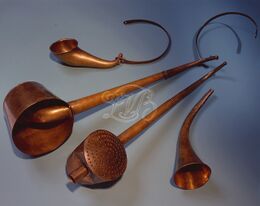
Website: http://www.beethoven-haus-bonn.de/sixcms/detail.php?template=startseite_digitales_archiv_de
The digital archive at the Beethoven-Haus, Bonn, contains manuscripts, sketches, letters, pictures, sample sound recordings, and much else. Beethoven lived here, and the physical museum also houses his instrument collection. A recently funded project involving the Beethoven-Haus and the Musikhochschule in Detmold will develop an ambitious "Beethoven Werkstaat" project taking viewers through the development of individual works by way of sketches and editions.
Beethoven Autographs Online
Website: http://www.bu.edu/beethovencenter/beethoven-autographs-online
Boston University's Beethoven Center offers several tools for Beethoven scholars and performers. Among them Beethoven Autographs Online is a one-stop shop for rare materials ranging from fragments, sketches, and cadenzas to complete manuscripts of full scores from libraries and private collections across Europe and North America. Its reference system conflates diverse work-numbering schemes into one easily searchable whole.
Beethovens Werkstatt (Beethoven's Workshop)
Website: http://beethovens-werkstatt.de/demo/index.html
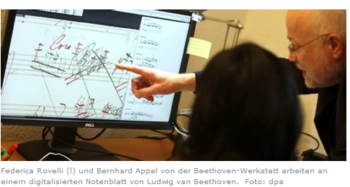
The ambitious Beethovens Werkstatt project, officially launched in 2014, will between now and 2030 reconstruct (with images and critical notes) the path of development of Beethoven's works from inception to completion. This project is based on the composer's sketch books, which in the digital version are to be carefully annotated with the help of the Music Encoding Initiative [MEI], a markup language for the encoding of musical sources facilitating their citation in critical editions. Bernhard Apel (Beethoven-Haus, Bonn) and Joachim Veit (Musikwissenschaftliches Institut, Detmold/Padlerborn) are the project directors. Johannes Kepper (Edirom project) is centrally involved in the technical development of both Werkstatt and MEI. The link above shows a prototype browser for viewing both manuscript iterations and modern notation for variants in the first movement of Beethoven's C-Minor Piano Sonata Op. 111 in Variants 14–17 (Beethoven-Haus BH 71).
Johannes Brahms Institute
Website: http://www.brahms-institut.de/web/bihl_digital/autographe.html
The Brahms Institute in Lübeck hosts a composite site for autographs, early editions, letters, and other kinds of documentation associated with Brahms. In this last category are such things as concert programs and fragments of music, drawings, and photographs of and by his associates.
See also the Johannes Brahms organization site.
Web Archive Anton Bruckner
Website: http://www.bruckner-online.at
The multi-faceted Anton Brucker web archive at the Austrian Academy of Sciences contains 26,000 images of the composer's autographs and early copies plus 6000 images of early prints. An associated database cites c. 10,000 works and related literature. The project is managed by Robert Klugseder. Online editions prepared with Edirom are in preparation.
John Cage Living Archive
Website: http://exhibitions.nypl.org/johncage/manuscripts
The New York Public Library for the Performing Arts, in collaboration with the John Cage Trust and the publisher C. F. Peters, hosts this sampler of Cage's physically diverse manuscripts. At a glance the reader can see the broad diversity of Cage's approaches--arithmetical, schematic, electronic, and aleatoric. A search engine has filters for video, manuscript, and ephemeral material. Video contributions of performances of Cage's music are actively sought via this form.
The Aaron Copland Collection (Library of Congress)
Website: http://www.loc.gov/collection/aaron-copland/about-this-collection
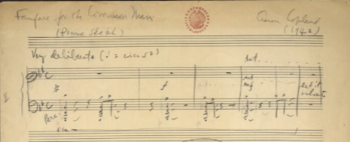
The Aaron Copland Collection, available at the Library of Congress, is an exceedingly rich one that contains every imaginable kind of evidence of the composer's long life (1900–1990)—manuscripts, sketches, typescripts for talks, personal photographs (roughly 5,000 of them), childhood mementos, and letters. Apart from photos, 981 other items can be found here.
Materials pertaining to Edvard Grieg
Website: http://bergenbibliotek.no/digitale-samlinger/grieg/english
Shortly before his death Edvard Grieg (1843-1907) arranged for the donation of all his music, letters, and related materials to the Bergen Public Library. The origins of the digitization project date back to 1993, the 150th anniversary of Grieg's birth. Grieg had a deep interest in recording technologies of his time. Starting in 1903 he made nine recordings of his music (on 78s), player-piano rolls from live-performance (Ludwig Hupfeld's Phonola and Welte-Mignon), and the Aeolian Company. For the last he suggested tempo mappings.
Handel's Messiah and other virtual "page-turners" from the British Library
Websites: See below.
The British Library's Virtual Books website contains a number of important manuscripts, the folios of which can be "turned" by the user. In addition to the autograph score of Handel's Messiah, "Sumer is icumen in", the Old Hall manuscript, the manuscript for Book II of J. S. Bach's Well Tempered Clavier, a Purcell anthem for the coronation (1685) of James II, sketches for Beethoven's Sixth ("Pastoral") Symphony, Elgar's "Enigma" Variations, and Mozart's musical diary (Zweig MS 63) are set up in similar fashion. A listing of other viewable musical works can be found here.
Handel autographs and other music manuscripts
The British Library completed the digitization of 38 Handel autograph manuscripts in 2016. They are accessed through the Library's "catalogs, archives, and manuscripts" website, where the user may limit the date range (slider at the bottom of the form). An author search for "Handel autographs" (currently yielding 168 hits) picks up unrelated miscellany, while a search for Handel alone produces a list of 103 titles. Items listed range from definitive scores of myriad operas, oratorios, cantatas, and other vocal and choral works to miscellaneous pieces (especially arias) collected by John Christopher Smith, Handel's copyist.
Among other composers represented, we find 311 manuscripts associated with the Bach family (52). Searches for other composers yield these figures: Thomas Arne (57), Giovanni Bononcini (58), William Boyce (115), William Byrd (141), Joseph Haydn (239), Orlando de Lassus (48), Benedetto Marcello (52), Wolfgang Amadeus Mozart (297), Pierluigi Palestrina (99), Giovanni Paisiello (84), Henry Purcell (233), and Alessandro Scarlatti (84), Franz Schubert (95), and William Walton (374).
The Handel autographs all have live links (2016), while many other listings currently contain catalog information. Holdings responding to composer searches may also yield correspondence, deeds, and other personal papers.
Michael Haydn Manuscripts
Website: http://daten.digitale-sammlungen.de/~db/ausgaben/uni_ausgabe.html?projekt=1384445203
181 comprehensive titles from the Bavarian State Library. The heavy emphasis on liturgical music reflects Haydn's lifetime involvement in church music, mainly in Salzburg and Vienna.
Gustav Mahler Autograph Manuscripts
Website: http://daten.digitale-sammlungen.de/~db/ausgaben/uni_ausgabe.html?projekt=1384445807
30 volumes of autograph manuscripts by Gustav Mahler are housed in the Bavarian State Library (Munich). Offerings include Das Knaben Wunderhorn, sketches for three symphonies, and Mahler's correspondence with Emil Hertzka.
Felix Mendelssohn Materials (Library of Congress)
Website: http://www.loc.gov/collections/felix-mendelssohn
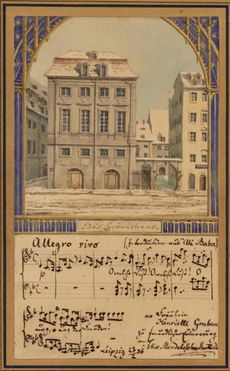
The Library of Congress holds a collection of miscellaneous Mendelssohn memorabilia that includes letters, lithographs, printed, and manuscript music. The illustration here shows a watercolor of the Gewandhaus, Leipzig, by Mendelssohn from the scrapbook of Henriette Grabau, a singer who appeared there when Mendelssohn conducted in 1836. The musical except beneath it comes from the Cherubini's opera Ali Baba. Manuscripts of the Lieder ohne Wörte and the Octet, as well as drawings from his travels in Italy, are among the holdings.
Carl Orff Autograph Manuscripts
Website: http://daten.digitale-sammlungen.de/~db/ausgaben/uni_ausgabe.html?projekt=1384446061&l=de
This collection of manuscript materials (91 titles) documents the musical career of Carl Orff (1895–1982). It includes, Lieder, stage works, modern arrangements of Monteverdi operas, and other materials. Because of continuing copyright restrictions, many items can be consulted only on site in the Bavarian State Library. Nonetheless the detailed listing is valuable in documenting the range of Orff's interests and activities.
Max Reger Autograph Manuscripts
Website: http://daten.digitale-sammlungen.de/~db/ausgaben/uni_ausgabe.html?projekt=1384445879&l=de
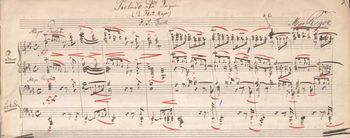
The music of Max Reger (1873–1916) occupies a unique place in the keyboard repertory of its time. His organ works are better known than his other music—concertos, Lieder, choral works, and a clarinet quintet. Forty titles are viewable here.
Cipriano de Rore: Illuminated Choirbook from the Court of Albrecht V
Website: http://daten.digitale-sammlungen.de/~db/0010/bsb00103729/images/index.html
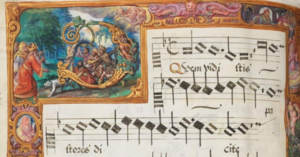
The brilliant colors and generous proportions of this choirbook, illuminated by Hans Mielich (1516-1573) for the Court of Albrecht V of Bavaria are stunning to behold. It is dated 1559. The books includes portraits of the duke, Duchess Anna, and of the composer. Rore (c. 1515-1565) was mainly active in Italy. He moved to Munich from Ferrara in the summer of 1559, which suggests that the bulk of the motets found here were composed prior to his arrival. Two volumes of his motets had been published in Venice in the 1540s. A further one followed in 1563.
The Arnold Schönberg Center
Website: http://www.schoenberg.at/index.php/en
The Arnold Schönberg Center in Vienna holds a cornucopia of Schönberg memorabilia that extends to film footage of the composer's real-world experiences such as being briefly employed as an auto salesman, his "contacts" list, and personal photographs, provides an online list of works, biographical sources, and information on performing rites. Autograph fair copies, sketches and drafts of Schönberg's compositions; autograph manuscripts and other primary sources for Schönberg’s theoretical writings and literary works; writings on musical pedagogy, as well as lectures and teaching materials; early printed copies of Schönberg’s works, including autograph annotations, performance instructions, and revisions; personal documents; Schönberg’s complete library; programs, reviews, posters; photographs and audiovisual documents all form part of the collection.
Schubert Online
Website: http://www.schubert-online.at

Schubert Online offers combined access to a total of 636 autograph scores, letters, and other documentation on Schubert. Much of the work was facilitated by the Vienna Science and Technology Fund [WWTF or Wiener Wissenschafts-, Forschungs- und Technologiefonds]. Digitized holdings come from Vienna's City Hall [Rathaus], the Austrian National Library, the State Library of Berlin, and the National Library of Norway, with intellectual contributions from the Music and Psychology program in Cologne and the Musicology Institute at the University of Vienna. Full-text search is supported for the letters. Deutsch Numbers are used to identify the manuscripts.
Strauss Online
Website: http://www.digital.wienbibliothek.at/nav/classification/301934
The music of three Johanns (father, son, uncle), one Josef, and one Eduard is represented at this website based at the city library of Vienna. More than 300 works are available here. Almost 200 of them are by Johann Strauss the younger, the waltz king. A few sketches, operettas, marches et al. are included. The minor Strausses composed polkas as well as other short instrumental pieces. Eduard's Theorie der Musik from c. 1845-50 can be downloaded here. An online catalogue of the library's printed works is available here.
Richard Strauss: Musical Autographs
Website: http://daten.digitale-sammlungen.de/~db/ausgaben/uni_ausgabe.html?projekt=1384446235
Among these 84 titles are numerous sketches, fragmentary compositions, and Lieder. The originals are held in the Bavarian State Library.
Verdi Online
Website: http://www.verdi.san.beniculturali.it/verdi/?lang=it
The Verdi Online collaboration hosts diverse materials--libretti, letters, portraits and figurines, bibliography, discography, and large quantites of background information about places and people associated with Giuseppe Verdi.
Georg Josef Vogler Music Manuscripts
Abbe Vogler (1749–1814) left a substantial collection of manuscripts (75 titles) that includes chamber and sacred music, concertos and symphonies, plus several items that relate to his opera Castor et Pollux.
Richard Wagner: Notebooks, music manuscripts, and correspondence
This collection of unpublished materials from the archive of the Bavarian State Opera brings Wagner's goals and working habits into our midst. Under 170 rubrics it documents the composer's movements, collaborators, and evolving ideas about music and role of music in society. They also give a more rounded view of his range of interests than many published accounts.
Robert Ward Papers
Website: https://archives.lib.duke.edu/catalog/wardrobert
Robert Ward was an American composer primarily of operas, instrumental works, and symphonic choral works. He won the 1962 Pulitzer Prize in Music for his opera, The Crucible, which remains his best-known work. His exceptionally long life (1910-2012) enabled him to compose for 95 years! Ward studied at the Eastman School of Music in the 1930s and subsequently taught at Columbia University, North arolina School of the Arts, and Duke University.
Manuscripts of Ermanno Wolf-Ferrari
Website: http://daten.digitale-sammlungen.de/~db/ausgaben/uni_ausgabe.html?projekt=1384446335&l=de
Ermanno Wolf-Ferrari (1876–1948) followed the path of aspiring students of his time in examining the details of earlier composers' practices. This collection of his manuscripts (175 titles) includes transcriptions of keyboard works by J. S. Bach, sketches of operas, concertos, symphonies, comic operas, a passion, sonatas, string quartets, and other chamber music.
By Collection
Corpus Musicae Ottomanicae (CMO)
Website: https://www.uni-muenster.de/CMO-Edition/cmo/cmo.html
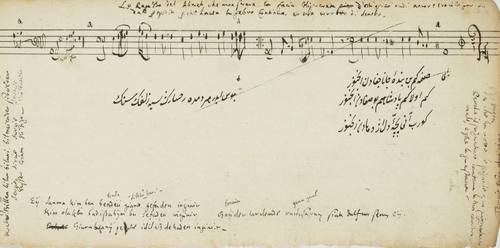
This recently announced project (2020) to digitize and transcribe manuscripts of Middle Eastern Music, named the Corpus Musicae Ottomanicae (CMO), concentrates on musical materials originating in the Middle East in the seventeenth through nineteenth centuries. A digital critical edition based on the collection is being prepared under the auspices of the Institute for Arabic and Islamic Studies at the Westphalian University in Münster, DE. Detailing of musical performance practices is an intended area of focus. ʿAlī Ufuḳī, sold to the sultan's court in Istanbul as a slave in the seventeenth century, was a rapt student of culture who gathered vast quantities of information about language and customs during his many years at court. He transliterated texts and notated melodies provide offer glimpses of style ad substance that are rare, for in general music was not notated. Custom required the music to be read from right to left.
Digital Collections in the Berlin State Library
Website: http://digital.staatsbibliothek-berlin.de/suche/?DC=musik
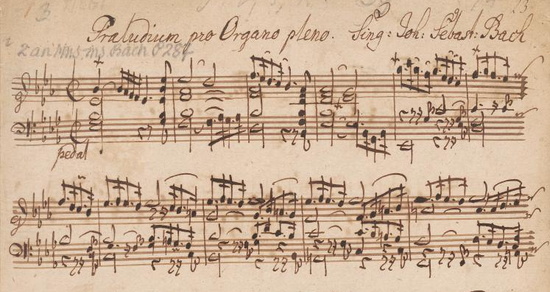
The 7,348 digitized music items at the Berlin State Library website include manuscripts, prints, libretti, poetic texts for Lieder, and much else. Of interest to Beethoven scholars are the composer's conversation books (1820, 1825, 1826). Other offerings include writings by and about https://en.wikipedia.org/wiki/Richard_Wagner Richard Wagner}; music in manuscript by Franz Liszt; letters to Clara Schumann by Johannes Brahms (and many others); prints, manuscript, and letters by Felix Mendelssohn; and copious amounts of eighteenth-century music, some of it in nineteenth-century manuscript copies.
Digitized Manuscripts in the University and Regional Library Darmstadt
Among the 2,909 music manuscripts in the music section of this heterogeneous collection, those of Christoph Graupner play a major role. (See the Graupner entry under Thematic Catalogues.) Most of the items come from the long eighteenth century, when they sustained the life of the court and the city. Other composers of note include Attilio Ariosti, Jo. Chr. Bach, Georg Benda, Jo. Friedrich Fasch, Jo. Gottlied Graun, Jo. David Heinichen, G. Ph. Telemann, Abbé G. J. Vogler, and several nineteenth-century masters.
Rare Music Manuscripts in the British Library
Website: http://www.bl.uk/onlinegallery/onlineex/musicmanu
See the Old Hall manuscript, Purcell's coronation anthem for James II, an excerpt from Handel's Messiah, Bach's autograph for Book Two of the Well-Tempered Clavier, Mozart's thematic catalogue of his composition, Beethoven's sketches for the Sixth Symphony ("Pastoral"), and much else. (Music manscripts make up just one part of the holdings viewable at this portal.)
E-codices: The Virtual Manuscript Library of Switzerland
Website: http://www.e-codices.unifr.ch/en
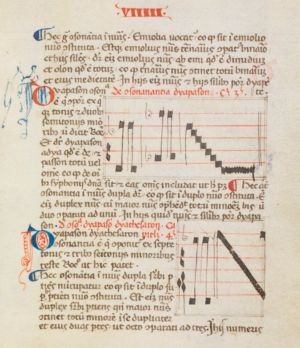
In many ways e-codices, the Virtual Manuscript Library of Switzerland, is an unsurpassed example of maximal access to fundamental but rarely seen sources. Currently serving almost 1,400 parchments and manuscripts, its online existence began in 2007. Its value to musicology owes partly to a tight coupling between early histories of music and the sources on which these accounts were often based. The digital apparatus is very clearly articulated, and it search by many rubrics is possible. Access to color images of the materials long known only from running-text summaries of them enables users to pose new questions of interpretation. Users can construct new juxtapositions and concatenations of source details in relationships that could not previously be explored. An annotation tool enables users to highlight pertinent findings. e-codices is based on like-named software, which holds the distinction of running equally well on mobile and non-mobile platforms. An author list is available here.
Among its many riches to be found are these rare items:
- Writings of Hucbaldus (840–930) from the Benedictine abbey at Einsiedeln.
- The Ars contrapunctus of Philippe de Vitry (1291–1361) from the Benedictine abbey at Einsiedeln.
- Fragment (in Latin) of a writing by Moses Maimonides (1135–1204).
Recent software enhancements and links for the e-codices newsletter are available. A tablet viewer also exists.
Early Keyboard Manuscripts at Yale University
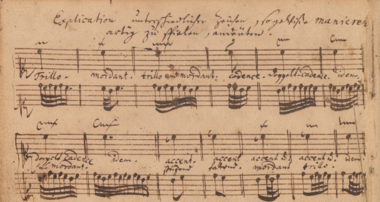
The Beinecke Library at Yale University holds substantial collections of music manuscripts, not all of it digitized to date. Highlights include not only notebooks for members of the Bach family but also chorale settings, manuscripts by Alessandro Scarlatti, seventeenth-century English music for instrumental ensembles, and transcriptions by Ezra Pound. The Orbis catalogue linked includes a wide range of items.
Fragmentarium
Website: https://fragmentarium.ms
Fragmentarium is not so much a single project as a global effort in digital restoration to locate, identify, and, where possible enhance nominally lost fragments of medieval manuscripts. The material is not exclusively musical, but since music was an adjunct to medieval manuscripts, Fragmentarium's availability to music scholars is an important resource. Fragmentarium is based at the Universiuty of Fribourg (CH) and is directed by Christoph Früeler. As of May 2022 it included nearly 3,000 items.
Gaffurius Codices Online
Website: https://www.gaffurius-codices.ch/s/portal/page/home
Franchinus Gaffurius (1451–1522) was a noted music theorist whose compositions, largely associated with his tenure as maestro di cappella at the Milan Cathedral, are little known. The Gaffurius Codices Online is devoted to inventorying the four Libroni containing the sacred vocal music he composed at this time, which coincided with the peak of Milan's Sforza rulers. (Leonardo da Vinci enjoyed a great deal of patronage from the Sforza family.) Gaffurius was a near contemporary of Josquin des Prez. The chief focus of this project is on the motets contained in the four large volumes. The contents will be captured in IIIF images suitable for sophisticated uses in a digital environment. A database containing important metadata will be developed in conjunction with the imaging. A digital critical edition is intended at a later time. the Gaffurius project is being developed by the Schola Cantorum Basiliensis in conjunction with the Swiss National Science Foundation.
Handrit: Historical (Music) Manuscripts from Iceland
Website: http://handrit.is/en/Handrit
This collection from the National and University Library, Reykjavik, contains historical manuscripts from Iceland. To find music, select Browse, Keywords, Arts, Music. Sources range from the 15th through 19th centuries.
Integrated Database for Early Music (IDEM)
Website: http://www.idemdatabase.org/alamire
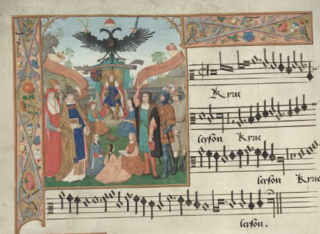
The Integrated Database for Early Music (IDEM), seated in the Musicology Research Unit (Katholieke Universiteit, Leuven), is an interdisciplinary, multifaceted database of manuscripts and printed books. Under the auspices of the Alamire Foundation, an international center for the study of music in the Low Countries, IDEM focuses on the musical heritage of these countries from the early Middle Ages until 1800.
The IDEM collection of digital images is coordinated with a central database of primary sources. Images are digitized by the Alamire Digital Lab, which provides high-technology photography at its Centre in Leuven, where state-of-the-art equipment allows musical sources to be photographed following strict quality requirements.
The Juilliard Manuscript Collection
Website: http://juilliardmanuscriptcollection.org/composers
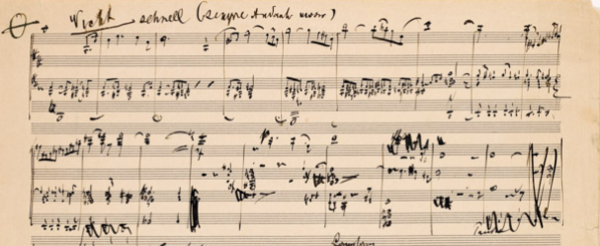
Among its 221 music manuscripts posted online, the Juilliard School possesses many unexpected items and substantial coverage of twentieth-century British and American composers (Samuel Barber, Frank Bridge) and many European composers whose music was popular in the US. Other collections represented at Juilliard include the collections of pianist Arthur Rubinstein and the popular composer of musicals Meredith Wilson (1902–1984).
Music Gifts for the Russian Emperors
Website: http://expositions.nlr.ru/MusicalManuscripts/eng/project.php
The National Library of Russia has made available this carefully curated collection of music given to Romanov emperors by visitors from France, Italy, Germany, and elsewhere. Many holdings come from Russia, where Western European music was introduced early in the eighteenth century. Holdings come from the 18th–20th centuries. Some of the music was brought by foreign teachers (e.g., Vincenzo Manfredini) for the royal progeny. Many works were provided with dedications to the emperors. Czech and Austrian music flowed copiously into Moscow at the end of the eighteenth century. A "Festival Song" by Felix Mendelssohn has a particularly interesting history, which is related here. The digitized pieces are linked to a database containing information about the social context and pertinent musical detail. The list of manuscripts (using Cyrillic script) can be found here, while a search engine (Roman script) is here. Drop-down lists contain listing in both Cyrillic and Roman, as appropriate, while the popup keyboard facilitates Cyrillic input. Source descriptions are in Russian.
Music Manuscripts in the Bavarian State Library
This rich collection of 2,697 digitized manuscripts is well endowed with music of the eighteenth and nineteenth centuries. Sample holdings include Alessandro Scarlatti's Missa Clementina, Antonio Caldara's sacred cantata "Gesu Cristo condannato", sacred vocal music by Michael Haydn, Handel's Deidamia, works by Karl Ditters von Dittersdorf, Dallapiccola, stage works by Richard Strauss, manuscripts of Carl Orff, and much other music.
The Moldenhauer Archives (Contemporary Music in Manuscript)
Website: http://memory.loc.gov/ammem/collections/moldenhauer/index.html
The Moldenhauer Archives began with the focus of teaching music history through primary sources. Its founder was Hans Moldenhauer (1906-1987) made the collection a memorial after his wife, Rosaleen, and donated it to the Library of Congress and eight other libraries including the Paul Sacher Stiftung (Basel), others in Cambridge MA, Evanston IL, Munich, Vienna, Zurich, and two in the state of Washington with which the Moldenhauers had personal connections--Washington State University and Whitworth College in Spokane. Its 3,500 manuscripts and letters, while representing a history of music and musical notation from ancient to recent times, is particularly valuable for its autographs of the latter. An online guide documents its contents, in many cases with essays on individual holdings.
Music Manuscripts in the Marciana National Library (Venice)
Website: Internet Culturale: Music Manuscripts in the Marciana National Library
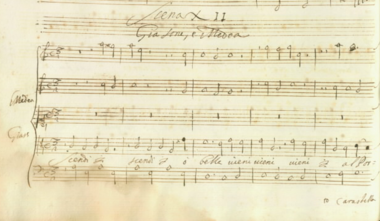
The Library of St. Mark (or Biblioteca Nazionale "Marciana") in Venice holds acquisitions that have been accumulating since the sixteenth century. Following guidelines widely shared across music libraries in Italy, it has digitized music manuscripts that are most closely tied to Venice's musical history. These include many important sources for seventeenth-century Venetian opera (Francesco Cavalli, Domenico Freschi, Giovanni Legrenzi, Carlo Pallavicino, P.A. and M.A. Ziani (operas can be accessed by act); 66 volumes containing cantatas of the eighteenth century by Benedetto Marcello (471 titles) and his nemesis Antonio Lotti; minuets by Baldassare Galuppi; and all the keyboard sonatas of Domenico Scarlatti (358 titles).
Music Manuscripts Online
Website: http://www.themorgan.org/music
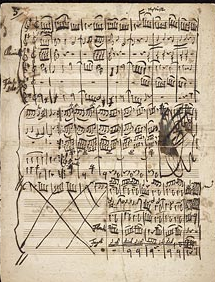
This collection of more than 700 manuscripts at the Morgan Library (New York) comes chiefly from eighteenth- to early twentieth-century composers (including but not limited to J. S. Bach, Beethoven, Brahms, Cherubini, Chopin, Debussy, Fauré, Gershwin, Glinka, Gluck, Handel, Haydn, Herbert, Liszt, Mahler, Massenet, Mendelssohn, Meyerbeer, Mozart, Mussorgsky, Paër, Pergolesi, Puccini, Saint-Saëns, Schubert, Schumann, and Wagner). An integrated browsing tool takes the viewer through music prints and manuscripts. The Library has recently made available its Goode EReader. Readers may now download images of manuscripts not currently under copyright. Searchable composer and manuscript lists facilitate individual searches.
Nuova Biblioteca Manoscritta (NBM)
Website: https://www.nuovabibliotecamanoscritta.it/catalogo.html
The Nuova Biblioteca Manoscritta (New Manuscript Library) is a regional resource for locating (and somertimes viewing) manuscripts from the modern Venetian state. It contains almost 30,000 items, but fewer than 500 of these contain music. Many other regional resources in Italy (e.g., Florence, Lombardy) and national catalogues are listed in online catalog of the Biblioteca Scuola Superiore Normale.
ORFEUS: The Post-Tridentine Music of Silence in the Cloister of S. Bento de Castris, Evora
Website: http://www.orfeus.pt
Thirteen choirbooks from the sixteenth to the eighteenth centuries in the monastery of S. Bento de Castris, Evora (Portugal), have been digitized by CIDEHUS, the Interdisciplinary Centre for History, Culture, and Societies. Luis Hennriques directs the project. The choirbooks are described individually here.
Music Treasures Consortium
Website: http://lcweb2.loc.gov/diglib/ihas/html/treasures/treasures-home.html
This aggregation includes both manuscript and out-of-copyright printed sources in more than a dozen institutions in the US, UK, and Germany. The browsing pages links users to the individual collections. The material is highly diverse but comes principally from the nineteenth century.
POLONA
Website: http://polona.pl
Polona presents the digital collections of the National Library of Poland. Digitized manuscripts and printed music are available. Registered website users can save materials to their own collections. Printed music can be found under Biblioteka, then Nuty. Manuscripts can be found under Biblioteka, then Rękopisy; from there, go to the filters and select Gatunek, then rękopisy muzyczne. Filters are available for authors, publishers, languages, form/genres, keywords, and century.
Saxon State Library (SLUB), Dresden: Royal Private Music Collection
This rich collection of the Wettin court, starting from the time of August the Strong and continuing to 1896, when it was donated to the Royal Library, is rich in holdings of sacred vocal music and Italian opera. Today it resides in the Saxon State and University Library (SLUB in the German ordering). The online holdings have been subdivided into these components:
The Opera Archive, which includes libretti, scores, and extracts, is currently being digitized. It overlaps the collaborative project Opera in Italy and Germany (1770-1830). This collection contains roughly 650 operas and opera extracts from the years 1764 to 1900. The private collections of court and church music include 750 manuscripts from the years 1697-1763.
Saxon State Library (SLUB): Court Music in Dresden
Website: http://hofmusik.slub-dresden.de
The current familiar name of this collection, Schrank II, is the name of the cabinet in which this important collection was long stored. It is a rich collection of instrumental music, mainly from the eighteenth century. Much of it is in the hand of Johann Georg Pisendel, an intrepid transcriber and collector of Italian (particularly Venetian) instrumental music. It contains 1,795 listings in 1750 physical manuscripts. By clicking on the highlighted text in the first sentence of the description users can download a spreadsheet with a full listing of holdings, most of which are digitized and are linked to the RISM OPAC.
Slovenian Digital Library
Website: http://www.dlib.si
The Digital Library of Slovenia includes in its Pictures section scans of music (and articles about music) published in Slovenia. Select notno gravido from the left frame on the Pictures tab. Dates of sheet-music publication range from 1862 to 1930, with a strong concentration in the late 1920s. Songbooks, especially from the first decade of the twentieth century, are also numerous.
Spanish Digital Library (Biblioteca Nacional Hispanica)
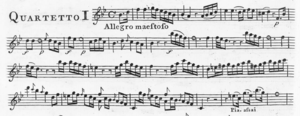
This heterogeneous collection of digitized materials--26,788 manuscripts and 4,347 printed sources--is impressive in its chronological and cultural range. Contains some eighteenth-century music for strings (Boccherini, Sacchini, et al.) and many sources from the late 19th and early 20th centuries.
By Repertory
Cambridge Lute Books
Website: http://cudl.lib.cam.ac.uk/view/MS-DD-00005-00078-00003/1
This link takes you to the second of four lute books compiled by Mathew Holmes and preserved in the Cambridge University Library. Its companions are the Cosens Lute Book and a volume of fragments of Elizabethan music for lute. Holmes was a singer at Christ Church, Oxford, and at Westminster Abbey. Cosens was a nineteenth-century owner of this collection of sixteenth-century music.
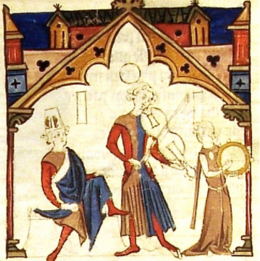
Cantigas Medievais Galego-Portuguesas
Website: http://cantigas.fcsh.unl.pt/manuscritos.asp
This website provides links to collections of manuscripts containing cantigas of Gallic and Portuguese origin. Many are preserved in the Vatican Library. The contents of each source is indexed, with full texts given in many cases. A sample folio is shown for each source. Titles are listed online.
Cantus Planus
Website: https://www.cantusplanus.at/de-at
In distinction to the Cantus Planus project focused on chant indexing (from the 1980s through today, under the auspices of the International Musicological Society), this website, operating under the auspices of the Austrian Academy of Sciences in Vienna, with a base at the Austrian National Library, provides a sophisticated array of digital tools and repositories for the study of medieval music. The scope of the project embraces six parts:
- Cantus Planus Austria: the primary web platform for the choral music in Austria
- Nationalbibliothek: Medieval music sources in the Austrian National Library
- Fragmente: Fragments of medieval music in the Austrian National Library
- Austriaca: Information on music manuscripts in Austrian libraries
- Text and Music Recognition: automatic recognition, transcription, and text acquisition of textual content in choral sourcces
- Bilddatenbank: an image bank of medieval music manuscripts.
Robert Klugseder directs the project.
Musica restaurata
Website: http://www.vaticanlibrary.va/home.php?pag=in_evidenza_art_00187
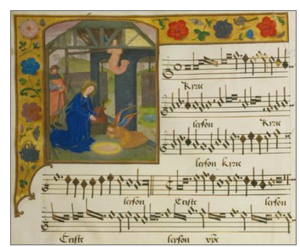
Illuminated manuscripts associated with the Low Countries in the Vatican Library can be viewed in high resolution owing to the generous support of the Alamire Foundation (Leuven, Belgium). The contents at the end of 2012 totaled 13,500 images. The image shown here comes from the workshop of Pierre Alamire (c. 1470–1536). Alamire's workshop produced many important manuscripts of the music of Johannes Ockeghem, Josquin des Prez, Adriano Willaert, and Pierre de la Rue. Alamire was a vendor of manuscripts who also used his innocent musical pursuits to conceal his operations as a spy for King Henry VIII. Manuscripts from his workshop can be found in several other European venues including Munich, Vienna, Brussels.
Polish Benedictine Music
Website: http://chrum.studiokropka.pl/st_test
This multifaceted project provides digitized images of sacred and liturgical music from Benedictine convents in the environs of Krakov. The musical sources are primarily from the 16th and 17th centuries. In addition to searchable digitized images, it also contains considerable metadata and many links to related resources as well as analytical information. An English translation is in progress.
Scottish Fiddle Tunes (Collections)
Website: http://hms.scot
More than 200 books of airs, reels, hornpipes, and strathspeys are reproduced at this website at the University of Glascow. Search by title, genre etc is facilitated in an associated databse. Some sources contain period annotations. The bulk are notated on two staves in the manner of keyboard music.
Swedish Musical Heritage
Website: http://www.swedishmusicalheritage.com
The Swedish Musical Heritage website represents an ongoing collaboration to make available all out-of-copyright music by Swedish composers. The alphabetical database of holdings is easily searched. It provides filters for instrumentation, composer's gender, century, and duration of each recording. Materials served include reproductions of scores, recordings of radio broadcasts, biographical information, and other related holdings of several musical institutions. Many Swedes were employed abroad, especially in Germany, and much foreign music found its way to Sweden via Germany.
Digital Reprints of Musical Repertory
Out-of-copyright editions reproduced in their entirety. Grouped by composer, collection (i.e. within a library or a series), publisher and sheet music (subjects variable, usually from one institution).
By Composer
Ludwig van Beethovens Werke
The first collected edition of Beethoven's music was published by Breitkopf & Härtel, in Leipzig, between 1862 and 1888. This set contains 269 titles—symphonies, concertos, chamber music, Lieder, folksong arrangements, and much more.
Brahms Institute: Digital Archive
Website: http://www.brahms-institut.de/web/bihl_digital/archiv_index.html
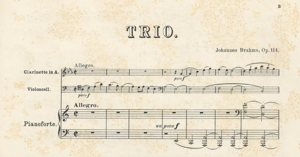
This website of the Brahms Institute in Lübeck (Germany) currently (2016) contains 42,000 images spreading across autograph manuscripts, early prints, photographs, concert programs, and personal documentation.
Chopin's First Editions Online (CFEO)
Website: http://www.cfeo.org.uk/about/description.html
This composite website, based at Royal Holloway College, London, serves more than 5,500 page images of early editions of Chopin's music. The project is headed by John Rink, with the collaboration of numerous holding institutions including the Bibliiothèque Nationale de France (Paris), the Bodleian Library (Oxford), the British Library (London), the University of Chicago, and the Chopin Institute (Warsaw). The separate listings below also function independently. The aim of the umbrella site is to facilitate close examination of sources in diverse collections and to coordinate early prints of Chopin's music with the Annotated Catalogue of Chopin's First Editions.
Jagiellonian Digital Library: Chopin holdings
Website: http://jbc.bj.uj.edu.pl/dlibra/collectiondescription?dirids=186
Featuring 17 volumes of Chopin's piano music at Jagiellonian Library in Kraków. The sites are under development.
University of Chicago: Chopin Early Editions
Website: http://chopin.lib.uchicago.edu
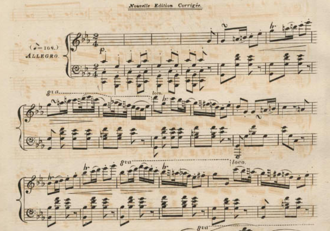
For an easy-to-consult listing of printed music by Chopin in the University of Chicago library, it is hard to surpass the Chopin Online Chopin Online Catalog. Citations are based on the library's shelfmarks, but since the music is digitized, users will have no difficulty in locating what they seek.
Online Chopin Variorum Editions (OCVE)
Website: http://www.ocve.org.uk/index.html
Not so much a single project as a whole constellation of Chopin-related research projects, John Rink's Chopin Variorum investigates such things as the work concept in Chopin's time and provides an annotated catalogue of first editions. Both are coordinated with The Complete Chopin: A New Critical Edition, printed in London (2004).
Georg Friedrich Händels Werke]
The Handel Gesellschaft edition of the composer's works (105 titles) was published by Breitkopf & Härtel between 1885 and 1902. It contains all but a few of the major works known today, sometimes with variants of arias or choruses that were excluded in later editions. [For earlier sources see "Lully" below.]
Franz Liszt Musikalische Werke
Website: http://daten.digitale-sammlungen.de/~db/ausgaben/uni_ausgabe.html?projekt=1193812455
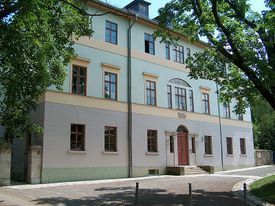
This collected edition of Franz Liszt's works (35 volumes) was published by Breitkopf & Härtel, Leipzig. Although the first volume appeared in 1870, the others appeared between 1900 and 1936. Symphonies, symphonic poems, works for piano and orchestra, Liszt's music criticism, and little-known arrangements are included. The picture at the left shows Liszt's residence from 1848 to 1861, while he was director of court music. Today the Liszt Haus serves as a museum.
Jean-Baptiste Lully Collection (University of North Texas)
Website: http://www.library.unt.edu/collections/music/lully
Twenty-six scores of Lully's best-known dramatic settings are preserved in the music collection of the University of North Texas (Denton TX). Together with arrangements and variants of works by Lully in the 182 holdings of the Virtual Rare Book Room a broad basis for study of Lully's milieu is available here. Dates of works in the broader collection extend to late in the nineteenth century. Among holdings that fall outside this description are a 1743 print of Handel's Alexander's Feast, the first printed edition (1767) of Handel's Messiah, the first version of George Grove's 4-volume Dictionary of Music and Musicians, London, 1879–90, and Girolamo Gigli's original libretto (1689) for an opera called La fede ne' tradimenti, which enjoyed many settings in Italy.
Felix Mendelssohn Bartoldys Werke
This collected edition (162 titles) of Mendelssohn's music was issued by Breitkopf & Härtel. String quartets, quintets, chamber music for clarinet and basset horn, piano trios, works for piano and cello, a fantasy on the Irish song "The last rose of summer" (Op. 15) and many other little-known pieces of chamber music can be found here together with more familiar fare.
Neue Mozart Ausgabe Online
Website: http://dme.mozarteum.at/DME/nma/start.php?l=4
A fully digitized version of the Neue Mozart Ausgabe has been available online since 2006. Series and volumes follow exactly the Bärenreiter print. All elements of the printed exemplars (table of contents, score, critical report) are present. Letters, documents, and libretti will be added by the Digital Mozart Edition at the Mozarteum, Salzburg, in cooperation with the Packard Humanities Institute. This is the only recent collected edition of the works by a major composer currently offered online.
Ignaz Pleyel Early Editions
Website: http://digital.lib.uiowa.edu/pleyel
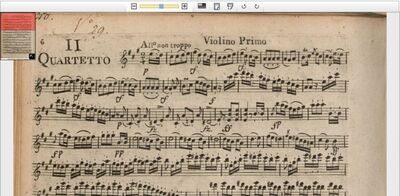
The late musicologist Rita Benton made an exhaustive study of Pleyel's editions (c. 1800) of the early string quartet literature. In the library named after her, more than 200 early editions and manuscripts give some sense of the scope of Pleyel's career as both a composer and a music publisher in the era of Haydn, Boccherini, and other notable composers of chamber music. In editions of chamber music for strings Pleyel also brought out piano pedagogy books and piano trios.
Franz Schuberts Werke
Website: http://daten.digitale-sammlungen.de/~db/ausgaben/uni_ausgabe.html?projekt=1259652551
The collected works of Franz Schubert, as published by Breitkopf & Härtel, Leipzig, 1884-1892. 53 volumes, including symphonic and piano works, choral works, theater pieces, piano four-hands arrangements, and song cycles.
Robert Schumann Werke
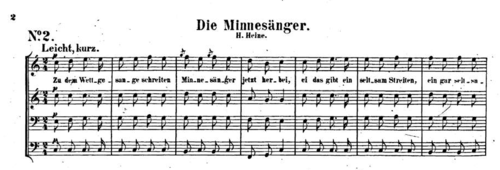
The works as edited by Clara Schumann and others. This series was published in Leipzig by Breitkoft & Härtrel between 1881 and 1893. The illustration shows the start of "Die Minnesänger" for four male voices, No. 2 from Schumann's Sechs Lieder.
Tomás Luis de Victoria
Website: http://www.tomasluisvictoria.es/en/content/center
The Centro d' Estusios Tomás Luis de Victoria (CEV) is a comprehensive one aimed at promoting greater familiarity with the music of the noted Spanish composer (1548-1611). To this end it offers a catalog and numerous reprints together with notices of events, podcasts, and a biography of the composer. Its website is optimized for mobile access (via smartphones and tablets).
The bibliographical apparatus is very clearly organized, and the CEV's integration of its diverse resources is a model of sensible organization. Since nearly all of Victoria's music is sacred vocal, the liturgical positioning of individual works is indicated. Links to texts, translations, and sources are fully covered. Some modern editions are credited to CPDL and IMSLP (in most cases relying on Pedrell's edition (Thomae Ludovici Victoria Abulensis Opera omnia), Leipzig 1902–13), while others are newly edited. It has links for discussion forums, facsimiles, monographs, and a discograhy.
Victoria entered musical life as a chorister in Ávila Cathedral, received his formal education and early professional experience in Rome, and upon his return to Spain (1577) entered the service of Dowager Empress Maria of Austria (daughter of Charles V, wife of Maximilian II, and mother of two other emperors) in Madrid. A priest, Victoria preferred convent life and declined several invitations to assume a more conspicuous post. His works consist mainly of masses (including parodies), motets (some sorrowful), Magnificats, Lamentations for Holy Week, and other species of liturgical music. Their performance attracted many listeners to the empress's convent.
By Collection
Monuments of German Music, Series 1
This 53-volume anthology of German music of the seventeenth and eighteenth centuries greatly increased familiarity with the music of Buxtehude, Telemann, J. Ch. F. Bach, Melchior Franck, Hasse, Scheidt, Stoltzer, and many others.
Monuments of German Music, Series 2 (Bavaria)
The second series of this well-known anthology, focused on Bavaria, emphasizes music associated with the Bavarian courts resident in Munich and (through composers such as Dell'Abaco) in exile in Brussels. Also represented are Stamitz, Haßler, Pachelbel, Pez, Steffani, Toeschi, and others. Published in 36 volumes (1901–1926).
Duben Collection Database Search
Website: http://www2.musik.uu.se/duben/Duben.php
The Düben Collection Database Catalogue is a digitised catalogue presenting meta-data and scanned facsimiles of the Düben Collection, a large and important collection of musical manuscripts and prints from the 17th and early 18th centuries. The compilation of the catalogue was initiated in 1987 and is a collaboration between Uppsala University and the University of Rochester.
Eastman School of Music/Sibley Music Library
Website: https://urresearch.rochester.edu/viewInstitutionalCollection.action?collectionId=63

The constantly growing digital collection of the Sibley School of Music is heterogeneous. It includes printed scores, manuscripts, and books—all of them in the public domain under U.S. copyright law. A large percentage of its holdings (currently 22,500 items) come from 19th- and early 20th-century America. Many items are unique.
Gaspari Online (Bologna Conservatory)
Website: http://www.bibliotecamusica.it/cmbm/tools/pro_dig.asp
The Gaspari Catalogue of holdings in the Bologna Conservatory is a resource well known to students of Italian music. It describes the heterogeneous holdings of what is now formally called the Museo Internazionale e Biblioteca della Musica di Bologna (the International Museum and Music Library of Bologna). Composed of multiple underlying libraries and collections, its holdings range from early liturgical sources to music of the twentieth century, from correspondence to musical instruments from earlier centuries to 4,000+ opera libretti (the Corago Project), most searchable from this start site. Under the same umbrella one can also find c. 400 portraits of musicians, mainly from nineteenth-century lithographs (as with Maria Malibran, shown at the right) and the voluminous eighteenth-century correspondence of Giambattista Martini, also edited in book form by Anne Schnoebelen.
Two collections--Corago (see under Libretti) and Ritratti di Musicisti (Musicians' Portraits: see under Image Banks/Iconoteca)--are listed separately.
Printed Music in the Bavarian State Library

This collection of 3,379 titles includes a large number of works from the eighteenth and early nineteenth centuries (Krebs, Türk, Danzi, Mendelssohn, and others). It also holds impressive early printed music, including Pierre Attaignant's seminal collection of Trente e six chansons musicales (1530), use of which is restricted to study. Clemens non Papa, Croce, Lassus, Rore, Vecchi, Wert, and Willaert are much in evidence, as are the publications of Pierre Phalèse the Elder.
Printed Music in the Prussian State Library
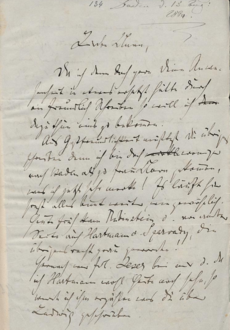
Among its treasures, the Prussian State Library in Berlin has recently uploaded (2016) 8,445 digital reprints covering a wide array of musical genres. Some obvious categories are music theory (including obscure tutors on harmony and counterpoint), folk music circulating in earlier centuries, musical dictionaries, comic operas, , hymns, psalm settings, spiritual songs, and a vast number of letters by composers. Our illustration shows one from Brahms, writing in Baden, to Clara Schumann, 15 August 1864. The exchange starts in 1855 and continues into the early 1890s. The date range is from the early sixteenth century to the early twentieth.
By Publisher
Nicolas Du Chemin: Chansons Nouvelles
Website: http://ricercar.cesr.univ-tours.fr/3-programmes/EMN/Duchemin/index.htm
Sixteen sets of books published by Parisian printer Nicolas Du Chemin between 1549 and 1568 are reproduced here in a collection that includes facsimiles, modern transcriptions, scholarly commentaries, and tools for research.
Sheet Music Collections and Miscellanies
University of Michigan list of sheet music collections
Website: http://guides.lib.umich.edu/c.php?g=282790&p=1884296
Sheet music denotes single pieces of music that were published prolifically in the US in parallel with the rise of the recording industry. Most items are for piano and voice, but popular songs were often transposed for several ranges. Many large collections survive in university libraries, and among them several are fully digitized. Redundancies in single-title listings are common, but in general each collection represents nearby publishers disproportionately.
The Sheet Music Cconsortium: A one-stop shop for cross-collection access
Website: http://digital2.library.ucla.edu/sheetmusic
This comprehensive search across many collections is made available by UCLA. The aggregate number of listings is truly staggering. Across 53 linked, indexed collections, we found close to 300,000 listings (April 2023). Most listed collections are in the US, but some inclusions come from the United Kingdom and Australia. This large aggregate corpus produces many redundancies, but sometimes the minute differences (or year, place, or cover art) are very informative. A search for Carrie Jacobs-Bond's "Perfect Day" produced almost 9,500 potential matches, with the earliest examples coming from 1910.
African American Sheet Music
Website: http://library.brown.edu/cds/sheetmusic/afam/index.html
The browsing facility for Brown University's online collection (1454 titles) is very easy to use. Some of the material (e.g. "Music Theater, 1865–1910) is also accessible at the Library of Congress "American Memory" website. Some uses are restricted.
American Sacred Music
This collection of digitized hymnals from the Mills College Music Library recalls the college's origins in 1851, on the heels of the California Gold Rush. The dates of the publications extend from 1833 to 1917.
American Vernacular Music Manuscripts
Website: https://archive.org/details/americanmusicmanuscripts
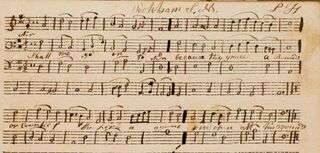
Murfreesboro, TN, the home of what is now called Middle Tennessee University, was a nexus of popular music-making before jazz established itself in Nashville. This collection of manuscript resources (c. 1730–1910) is full of miscellany but also offers documentation not available anywhere else. For most users the archive.org link given above will be more accessible than the university's Center for Popular Music server. To date 333 shelfmarks (many of them collections) have been uploaded. George Allen's "Reels, Clogs, Hornpipes, Jigs" is representative.
Archive of Popular American Music
Website: http://digital.library.ucla.edu/apam
UCLA's stupendous collection of popular music (450,000 items) is searchable by name, title, date, and cover art subject and several other categories of information. Covers only are scanned.
The Drs. Whitby Music Collection
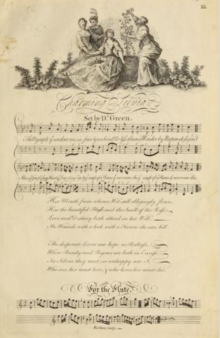
Website: https://archive.org/details/whitbymusic?&sort=-downloads&page=3
This Canadian collection (1,339 items) at the University of Western Ontario (Waterloo) consists mainly of instrumental music from the nineteenth century. Titles in music theory and pedagogy are abundant. Some unusual anthologies including George Bickham's Musical Entertainer (1740), a collection of arias with obbligato flute parts, are found among its eighteenth-century holdings.
Historic American Sheet Music HASM (Duke University)
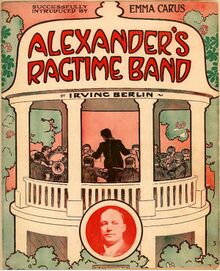
Website: http://library.duke.edu/digitalcollections/hasm
Duke University's Historic American Sheet Music collection (3,000+ titles) spans the time-period 1850–1920. It includes a song-lyrics index, has tabbed browsing, and provides helpful background on the sheet-music printing industry in the US. HASM is also linked to the Library of Congress's American Memory project. It has particular value for matching references in early film music, ragtime, and piano-rolls, that is for repertories that were known principally by ear. Searchable by subject, instrumentation, and illustrator as well as more usual parameters.
Irish Sheet Music Archives
Website: http://irishsheetmusicarchives.com/About-Us.htm
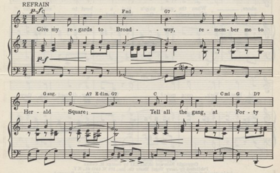
The Irish Sheet Music Archives website is the home of the online sheet music collections found in the Ward Irish Music Archives located in Milwaukee, Wisconsin. It enables searching, viewing, and in the majority of cases downloading its more than 5,000 scores of Irish and Irish-American sheet music. Those wishing to locate scores in the public domain (and therefore downloadable) are best off starting here, where the copyright status, instrumentation, and other details are clearly shown. Specialty subsections contain songs by George M. Cohan (1878-1942) and Harry Lauder (1870-1950), bagpipe pieces arranged for piano, and songs from the first world war.
Lester Levy Sheet Music Collection
Website: http://levysheetmusic.mse.jhu.edu
The Lester S. Levy Sheet Music Collection, based at Johns Hopkins University, contains 29,000 pieces (1780–1980). It is rich in popular music from the nineteenth century, particularly surrounding the years of military conflicts—the war of 1812, the Civil War (1861-65), and the First World War (1914–18). The collector wrote several books on specific subjects within the collection.
Lilly Library Sheet Music Collections
Website: http://www.indiana.edu/~liblilly/collections/sheetmusic.shtml

These collections at Indiana University are very large. Collectively they hold more than 275,000 pieces of American sheet music. Available materials can be searched with the In Harmony search page.
Music for the Nation: American Sheet Music 1870-1885
Website: http://www.loc.gov/collection/american-sheet-music-1870-to-1885/about-this-collection
This Library of Congress collection comes from copyright registrations. It is complemented by sheet-music repertories for the years 1820–1860 and the Civil War years that immediately followed.
Netherlands Radio Music Library
Website: http://www.muziekschatten.nl/action/category?id=1&order=composer&letterPage=v
This treasury of the Netherlands Radio Music Library in Hilversum contains nearly 5000 scores of classical, choral, light, and popular music (including manuscripts). Users can download and print PDF files from the Flash window. They are invited to upload their own sound recordings of the music they downloaded. Most "classical" works are by Dutch composers, and some are arrangements of scores originating elsewhere. Popular sheet music is chiefly from the late nineteenth and earlier twentieth centuries. Since the search pages are only in Dutch, a good starting point is the composer index.
Nineteenth-Century American Sheet Music (NcASM)
Website: http://www2.lib.unc.edu/dc/sheetmusic/index.html
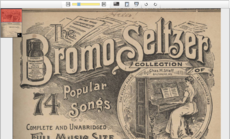
This University of North Carolina website holds almost 7500 digitized pieces from 1815 (music from the opera The Devil's Bridge to 1945 (an edition of Chopin's Polonaise Op. 53) as well as letters pertinent to holdings. The online catalogue search offers many options. Holdings include songs with piano accompaniment to duets, trios, and four-part glees.
Nineteenth-Century California Sheet Music
Website: http://people.ischool.berkeley.edu/~mkduggan/neh.html
The original holdings consisted of 2700 pieces published in California between 1852 and 1900. A further collection of 700 pieces was added in 2007. The project is maintained at the University of California, Berkeley. The pieces represent a wide range of Western US and native American traditions. Some sound, video, and MIDI files are also available.
St. Petersburg Score Collection
Website: http://www.jewishmusic-asjm.org/database-the-st-petersburg-score-collection.html
This collection located in St. Petersburg is maintained by the American Society for Jewish Music. Many published titles are in German and Russian. Publication took place in Kiev, New York, and several places between them.
University of North Carolina (UNC)
Website: https://archive.org/details/uncmus?&sort=-downloads&page=2
The UNC collection (3000+ items) represents categories of popular and religious music in use in the South Central US between 1880 and 1920. In addition, excerpts and short scores for operatic material and pedagogical material make up almost half the holdings. Robert Planquette's three-act comic opera Les Cloches de Corneville is currently the most viewed item. Beyond scans, this recourse offers 10 other download formats including epub, Kindle, Daisy (for print-disabled users), and many more.
University of Toronto Music Faculty Collection
Website: https://archive.org/details/facultyofmusic
The University of Toronto Music Faculty digitization project makes available more than 4,500 items reflecting, overall, the distribution of topical interests relating to music in Canada. The collection is evenly divided between sheet music and now-rare books. The pedagogical emphasis is pronounced. One of the most heavily used items is Theodore F. Freylinghuysen's Tonic Sol-Fa Music Reader (1890), published under his pseudonym Seward.
World War I Sheet Music
Website: http://www.loc.gov/collection/world-war-i-sheet-music/about-this-collection
This collection at the Library of Congress contains almost 14,000 items, all of which are fully digitized. The materials include not only conventional prints but also privately published and unpublished (amateur) material.
Yiddish Sheet Music
Website: http://library.brown.edu/cds/sheetmusic/yiddish/about.html
This special collection at Brown University contains roughly 2,000 items. Much of it represents the Yiddish-language musical stage in Russia around around 1900. Holdings include works by Bores Thomashefsky, the grandfather of Michael Tilson Thomas.